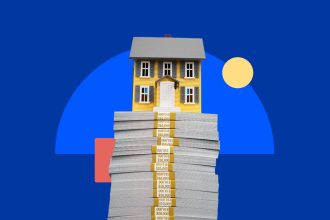Key takeaways
- From 2007 to 2021, average renters insurance premiums fell by more than 28 percent, while average homeowners insurance rates increased by more than 31 percent.
- Over that same period, the gap between average renters insurance premiums and average home insurance premiums has grown by 378 percentage points.
- The gap between average renters and homeowners insurance rates from 2007 to 2021 grew the most in Oklahoma, Colorado and Rhode Island.
- The difference between homeowners and renters insurance rates was the most minimal and consistent in Delaware, Alaska and Nevada from 2007 to 2021.
Johna Strickland is no longer a homeowner. In 2021, she sold her house in Folkston, Georgia and moved closer to her family in Boise, Idaho. It wasn’t just a desire to be closer to kin that made her put up a “for sale” sign; she was sick of owning.
“Owning a house [was] stressful, and maintaining and improving my property took the majority of my free time and money,” she told Bankrate. “I wanted to let someone else worry about the fence falling down and spend my time and money in other ways.”
Now, she rents an apartment in North End, a neighborhood she describes as one of Boise’s best. By renting, Strickland says she’s able to live in a neighborhood that she’d be priced out of if she were buying. Plus, by moving to North End, Strickland says she’s living the life she actually wanted.
Strickland isn’t the only one making the switch. According to Bankrate’s Rent vs. Buy Study, renting is more affordable than buying in all 50 of the largest U.S. metros. In some cities — namely San Francisco, San Jose and Seattle — the cost of owning is more than double that of renting.
Insurance is just one of the factors in a monthly housing budget, for renters and homeowners alike. If you have a mortgage, your lender will likely make you carry a home insurance policy; if you’re a renter, your landlord may make you have insurance as a part of your lease agreement. To see whether insurance premiums could help explain the affordability gap between owning and renting, Bankrate analyzed average homeowners and renters insurance rates from the Insurance Information Institute (Triple-I), ranging from 2007 to 2021. Our analysis showed that the pace of increase in homeowners insurance far exceeded that of renters insurance with a cost gap that more than doubled over the 14-year period.
Renters insurance got cheaper, homeowners insurance got more expensive
To compare homeowners and renters insurance rates, Bankrate analyzed average premium data from Triple-I. We weighed average rates from 2007 through 2021, the latest year available. Our team also used data from the Bureau of Labor Statistics to account for inflation and to convert all dollar figures into 2021 dollars.
The cost difference between insuring a rental vs. a home has grown significantly. In 2007, the national average cost of homeowners insurance was 352 percent higher than renters insurance. By 2021, a homeowners insurance policy cost 730 percent more than renters insurance — an increase of 378 percentage points. In terms of annual premiums, renters paid an average of $238 per year for an insurance policy in 2007, while homeowners paid $1,074. By 2021, renters paid $170 annually, while homeowners faced a heftier $1,411 per year bill.
Homeowners insurance went up in pace with inflation
While it’s become more expensive to insure a home, it’s actually become cheaper to insure an apartment. From 2007 to 2021, the average annual cost of renters insurance went from $238 to $170 — a more than 28 percent dip. Meanwhile, the average annual cost of homeowners insurance increased by more than 31 percent, going from $1,074 to $1,411 per year. This is on par with the Consumer Price Index — what economists use to measure inflation — which increased by almost 31 percent during that same timeframe.
Why is homeowners insurance more expensive than renters?
Part of the reason renters insurance rates are significantly cheaper is the nature of what a policy covers. A renters insurance policy primarily covers your personal belongings and liability exposure. If there’s damage to your building — say a storm blows some shingles off the roof or the basement floods — as a renter, you don’t have to pay for it. When you own your home, you own it from roof to foundation, and if your home sustains damage from a covered policy peril, your home insurance helps cover those repairs. Home insurance claims can get expensive quickly. In fact, property damage claims, inclusive of fire and lightning, water damage and freezing, wind and hail, theft, vandalism and malicious mischief, average around $15,570 per claim, according to Triple-I.
Nationally, the cost of home insurance has been on a steady incline over the past several years. Insurance is a complicated product, and its price can fluctuate due to a variety of different things. How much you pay for your policy will depend in part on factors that are individual to you as a homeowner like your credit history, martial status and whether you have filed a claim in the past. However, some things that affect your home insurance premium won’t have anything to do with you as a homeowner. If an insurance company paid out more in claims than it collected in premiums, it may raise rates across the board to recoup that money. Or, when reconstruction costs go up, you can expect home insurance rates to rise as well.
Homeowners insurance costs have skyrocketed in recent years. We’ve endured significant weather events ranging from hurricanes to wildfires, floods and tornadoes, so costs have risen to account for increased losses (and the fear that more homes could be vulnerable to these effects in the future). Building materials and labor costs have also risen, pushing insurance prices higher.
— Ted Rossman, Bankrate Senior Industry Analyst
“There are concerns that political developments could exacerbate both of these issues. For example, elevated tariffs on key inputs such as steel, aluminum and lumber will make it more expensive to build and repair homes. Appliances are likely to cost more as well. And reduced immigration has the potential to add to labor costs by shrinking the pool of available workers,” Rossman adds.
10 states with the largest gaps between renters and homeowners insurance rates
The cost gap between renters and homeowners insurance rates grew the most in Oklahoma. In 2007, the gap between renters and homeowners insurance rates was $1,086 per year. By 2021, the cost difference between these two policy types grew to $1,934, an increase of $848. Oklahoma sits in the middle of Tornado Alley, making it a hotbed for wind and hail damage. When an area is more prone to certain types of losses, you can usually expect home insurance rates there to be more expensive.
The gap between renters and homeowners insurance rates from 2007 to 2021 widened by more than $600 in Colorado, Rhode Island and Nebraska.
10 states with the smallest gaps between renters and homeowners insurance rates
In some states, the gap between average renters and homeowners insurance rates shrank. According to Bankrate’s analysis, the cost difference between renters and homeowners insurance decreased by $53 in Delaware from 2007 to 2021. The gap between renters and homeowners insurance rates increased by less than $100 in Nevada and Michigan over that same time period.
My home insurance premium went up. What can I do about it?
The rising cost of homeowners insurance has, in some areas of the country, become a major pain point. If you’re hit with an eye-popping premium when your policy renews, these strategies might help bring costs back down:
- Bundle your coverage: If you don’t already, bundling your auto and home insurance policies together can result in significant savings. For many insurance companies, a home and auto bundle yields the most savings compared to other discounts.
- Choose a high deductible: Choosing a higher deductible means you’ll pay more out-of-pocket if you need to file a claim. However, it means you’ll get a lower insurance rate.
- Improve your credit: In most states, your insurance company can use your credit history to price your policy. Taking steps to improve your credit could help significantly lower the cost of your home insurance policy.
- Address any roof repairs: A roof in need of repairs will also be more expensive to insure. Getting a roof inspection, fixing any issues and even replacing your roof with something more damage-resistant may cost more upfront but could result in longer-term savings and greater security that you won’t be dropped.
Read the full article here

















